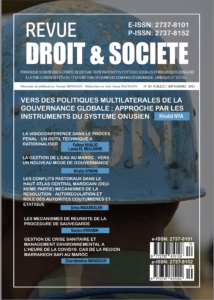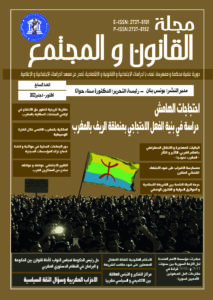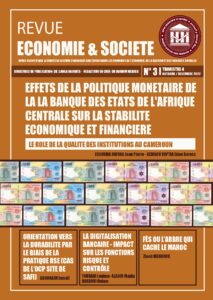
| HACHEMI Bentahar Professeur Universitaire Université Mohammed Premier,Oujda-Maroc |
| EL AOUADI Ouafa Doctorante en sciences économiques et de gestion Université Mohammed Premier, Oujda-Maroc |
Résumé :
Cet article examine la problématique de la compétitivité liée aux stratégies d’imitation. Afin de mieux appréhender cette compétitivité, diverses théories sont mobilisées. Notre étude se focalisera sur l’analyse des attributs des différentes réponses imitatives et sur leur corrélation avec le niveau de compétitivité.
Notre apport théorique met en évidence que l’adoption d’une stratégie d’imitation peut avoir pour effet de réduire l’avantage concurrentiel d’une entreprise rivale, de maintenir une égalité de compétitivité, voire de créer un avantage concurrentiel. Cette approche stratégique se manifeste à travers des réactions imitatives caractérisées par leur faible coût, leur rapidité, leur différenciation partielle, voire leur capacité à engendrer de nouveaux marchés. La validation empirique de cette proposition théorique ouvre la voie à des recherches futures.
Mots-clés : Stratégie d’imitation, compétitivité, avantage concurrentiel, réaction imitative, différenciation.
IMITATION AS A COMPETITIVE STRATEGY: APPROACHES AND IMPACTS IN A COMPETITIVE ENVIRONMENT
| HACHEMI Bentahar University lecturer Mohammed 1st University, Oujda, Morocco |
| EL AOUADI Ouafa PhD student in economics and management Mohammed 1st University, Oujda- Morocco |
Abstract:
This article addresses the issue of competitiveness related to imitation strategies. In order to better grasp this competitiveness, various theories are employed. Our study will focus on analyzing the attributes of different imitative responses and their correlation with the level of competitiveness.
Our theoretical contribution highlights that adopting an imitation strategy can lead to reducing a rival company’s competitive advantage, maintaining competitive parity, or even creating a competitive advantage. This strategic approach is manifested through imitative reactions characterized by their low cost, speed, partial differentiation, and even their ability to generate new markets. The empirical validation of this theoretical proposition paves the way for future research.
Keywords: Imitation strategy, competitiveness, competitive advantage, imitative response, differentiation
REFERENCES
Baize D. (1999). « De la contrefaçon à l’imitation », Revue française de Gestion, vol. 119, n° 25, juin-juillet-août, p. 76-81.
Barney J. B. (1991). « Firm Resources and Sustained Competitive Advantage », Journal of Management, vol. 17, n° 1, p. 99-120.
Barreto I. et Baden-Fuller C. (2006). « To Conform or to Perform? Mimetic Behaviour, Legitimacy-Based Groups and Performance Consequences », Journal of Management Studies, vol. 43, n°. 7, p. 1559-1581.
Baum A. C., Li S. X. et Usher J. M. (2000). « Making the Next Move: How Experiential and Vicarious Learning Shape the Locations of Chains’ Acquisitions », Administrative Science Quarterly, vol. 45, n°. 4, p. 766-801.
Bensebaa F. (2000). « Actions stratégiques et réactions des entreprises », M@n@gement, vol. 3, n° 2, p. 57-79.
Bolton M. K., (1993). « Imitation versus Innovation: Lessons to be Learned from the Japanese », Organizational Dynamics, vol. 21, n° 3, p. 30-45.
Bourkha B. (2012). « L’hyperimitation, un facteur déterminant de la dynamique concurrentielle : le cas de secteur bancaire marocain », XXIème Conférence de l’Association Internationale de Management Stratégique (AIMS), Lille, France, p. 31.
Brandes U., Hoefer M. et Lerner J. (2006). « WordSpace – Visual summary of text corpora », In Proc. IST/SPIE’s 18th Ann. Intl. Symp. Electronic Imaging (VDA ’06).
Cadix A. et Pointet, J. M. (2002). Le management à l’épreuve des changements technologiques. Impacts sur la société et les organisations, Organisation, Paris.
D’Aveni R. (1995). Hypercompetition, Vuibert, Paris.
Day R. et Pingle M. (1996). « Modes of Economizing Behavior: Experimental Evidence », Journal of Economic Behavior and Organization, vol. 29, n° 3, p. 196-209.
Deephouse D. L. (1999). « To Be Different, or to Be the Same? It’s a Question (and Theory) of Strategic Balance », Strategic Management Journal, vol. 20, n° 2, p. 147-166.
Delios A. et Henisz W. (2001). « Uncertainty, Imitation and Plant Location : Japanese Multinational Corporations 1990-1996 », Administrative Science Quarterly, vol. 46, n°.3, p. 443-475.
Demil B. et Lecocq X. (2006). « La malédiction des suiveurs : Mimétisme, mortalité et lock-in cognitif », XVème Conférence de l’Association Internationale de Management Stratégique (AIMS), Annecy, Genève, p. 23.
Demsetz H. (1982). « Barriers to Entry », The American Economic Review, vol. 72, n° 1, p. 47-57.
Dimaggio P. J. et Powell W. W. (1983). « The Iron Cage Revisited: Institutional Isomorphism and Collective Rationality in Organizational Fields », American Sociological Review, vol. 48, n. 2, p. 147-160.
Ethiraj S. K. et Zhu D. H. (2008). « Performance Effects of Imitative Entry », Strategic Management Journal, vol.29, n° 8, p. 797-817.
Garcia-Pont C. et Nohria N. (2002). « Local versus Global Mimetism: the Dynamics of Alliance Formation in the Automobile Industry », Strategic Management Journal, vol. 23, n° 4, p. 307-321.
Ghani, R. (2012). Contribution à la compréhension de l’adoption des ERP dans les PME marocaines : une approche structurationniste et culturelle. Thèse de doctorat, Université de Montpellier 1.
Greve H. R. (1996). « Patterns of Competition: The Diffusion of a Market Position in Radio Broadcasting », Administrative Science Quarterly, vol. 41, n° 1, p. 29-60.
Greve H. R. (1998). « Managerial Cognition and the Mimetic Adoption of Market Positions: What you See is What you Do », Strategic Management Journal, vol. 19, n° 10, p. 967-988.
Haunschild P. R. et Miner A. S. (1997). « Modes of Interorganizational Imitation: The Effects of Outcome Salience and Uncertainty », Administrative Science Quarterly, vol. 42, n° 3, p. 472-500.
Hippel V. E. (1982). « Appropriability of Innovation Benefit as a Predictor of the Source of Innovation », Research Policy, vol. 11, n° 2, p. 95-115.
Ingham M. (1995). Management stratégique et compétitivité, De Boek Université, Bruxelles.
Koenig G. (1996). Management stratégique: paradoxes, interactions et apprentissages, Nathan, Paris.
Kotler P. (1997). Marketing Management: Analysis, Planning, Implementation and Control, Prentice Hall, New Jersey.
Lee K. et Pennings J. M. (2002). « Mimicry and the market: Adoption of a new organizational form », Academy of Management Journal, vol. 48, n° 1, p. 144-162.
Lee R. P. et Zhou K. Z. (2012). « Is Product Imitation Good for Firm Performance? An Examination of Product Imitation Types and Contingency Factors », Journal of International Marketing, vol. 20, n° 3, p. 1-16.
Leroux E. et Pupion P. C. (2006). « Diffusion des erp et comportements mimétiques», XVème Conférence de l’Association Internationale de Management Stratégique (AIMS), Annecy, Genève, p. 24.
Levitt T. (1966). « Inoovation Imitation », Harvard Business Review, vol. 44, n° 5, p. 63-70.
Li J. et Kozhikode R. K. (2008). « Knowledge management and innovation strategy: The challenge for latecomers in emerging economies », Asia Pacific Journal of Management, vol. 25, n° 3, p. 429-450.
Lieberman M. B. et Asaba S. (2006). « Why do Firms Imitate Each Other? », Academy of Management Review, vol. 31, n° 2, p. 366-385.
Ma H. et Karri R. (2005). « Some sure ways to lose your competitive advantage », Organizational Dynamics, vol. 34, n° 1, p. 63-76.
Mansfield E. (1985). « How Rapidly does New Industrial Technology Leak Out? », Journal of Industrial Economics, vol. 34, n° 2, p. 217-223.
Mansfield E., Schwartz M. et S. Wagner (1981), « Imitation costs and patents : an empirical study », The Economic Journal, vol. 91, n° 364, p. 907-918.
Montant E. et Pupion P. C. (2004). « Le rôle du mimétisme dans les choix fiscaux », Comptabilité – Contrôle – Audit, vol. 10, n° 1, p. 103-126.
Mouricou P. (2009). « Les stratèges sont-ils des moutons ? Revue de la littérature et perspectives pour la recherche en Stratégie », XVIIème Conférence de l’Association Internationale de Management Stratégique (AIMS), Gronoble, France, p. 30.
Peteraf M. A. (1993). « The cornerstones of competitive advantage: a resource-based view », Strategic Management Journal, vol. 14, n° 3, p. 179-191.
Philippe L. L. (1984). L’imitation des modernes – typographies II, Galiliée, Paris.
Porter M. E. (1986). L’Avantage concurrentiel : comment devancer ses concurrents et maintenir son avance, InterEditions, Paris.
Posen H. E., Lee J. et Yi S.(2013). « The power of imperfect imitation », Strategic Management Journal, vol. 34, n° 2, p ; 149-164.
Rivkin J. W. (2000). « Imitation of Complex Strategies », Management Science, vol. 46, n° 6, p. 824-844.
Schnaars S. P. (1994). Managing imitation strategies, The Free Press, New York.
Smith K. G., Grimm C. M., Gannon M. J. et Chen M. J. (1991). « Organizational Information Processing, Competitive Responses, and Performance in the US Domestic Airline Industry », Academy of Management Journal, vol. 34, n° 1, p. 60-85.
Ulhoi J. P. (2012). «Modes and orders of market entry : revisiting innovation and imitation strategies », Technology Analysis and Strategic Management, vol. 24, n° 1, p. 37-50.
Valdani E. et Arbore A. (2007). « Strategies of imitation: an insight », Problems and perspectives in Management, vol. 5, n° 1, p. 198-206.





Comments are closed, but trackbacks and pingbacks are open.